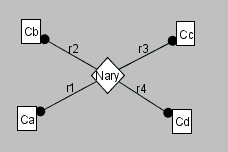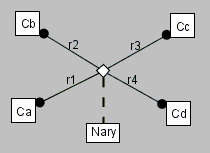- From: Marijke Keet <keet@inf.unibz.it>
- Date: Fri, 18 May 2007 15:02:08 +0200
- To: public-semweb-lifesci@w3.org
- Message-ID: <464DA3D0.6070902@inf.unibz.it>
Phillip Lord ha scritto: >>>>>> "MK" == Marijke Keet <keet@inf.unibz.it> writes: >>>>>> > > MK> Regarding “reification design patterns” and the reification & > MK> OWL (not the thorny logic-based representation of beliefs et > MK> al), permit me to mention that support for n-ary relations > MK> ---where n may also be >2--- in description logics is already > MK> possible with DLR [1] and implemented with reasoner-support in > MK> the iCOM tool (the tool may not live up to end-user-level > MK> expectations on userfriendliness, but it works) [2]. > > > Out of curiosity, can you describe how different or similar this is to > the result that you can achieve in the N-ary relation design pattern > for OWL? > taking the "n-ary relations" pages of robert stevens' presentation on design patterns as comparison with DLR, with the design patterns & OWL then the modeller has to decompose the piece of knowledge to be represented into binary relations and then somehow relate those binary relations where one binary somehow takes precedence over the other(s), i.e. choose which one of the binaries to reify, or reify first. This my be relatively easy to decide upon if the third one is a datatype (then the situation is comparable to an attribute of an association in e.g. UML), but with three DL-concepts, let alone 4 or more, this is far from trivial with reification upon reification (or "directions" for "in-" and "outgoing" arrows). And what if another modeler wanted to represent the same, but did the reification with one of the other binaries & arrows and subsequently integrate the two ontologies... In contrast, in DLR where one wants e.g., a quaternary relation R with concepts Ca...Cd, then either a) typing assertion as $R \subseteq (1: Ca) \sqcap (2: Cb) \sqcap (3: Cc) \sqcap (4: Cd) $, so the concepts participate in the relation as four equals b) with objectified relation, then the quaternary relation gets reified into R', with binaries to the four participating concepts and/or datatypes; hence, without having to judge on which component is (subjectively?) more important and having a 'flat' structure instead of a stack of reifications. admitted, the assertions don't look nice in DL, so from the perspective of usability, tool support is desirable; see also the two simple diagrammatic versions (made in iCOM, I can send the not-for-human-consumption DIG representation for those of you interested in it.) A simpler version is available in DL-LiteA through the options with role values (informally: ternary with two concepts and a datatype). "use case 3" of [1] for the TBox level comes closest in approach, although there the point of departure are binaries, whereas with DLR your point of departure ---and where the user stays--- are n-aries. > Obviously, building things into the DL is nice, but it's not currently > representable in OWL, so would require tooling support, while the OWL > N-ary relation pattern doesn't. > it could be added to OWL... so I guess you'd have to ask them to get it in. In the meantime that it is not in OWL, it either needs tooling support or a manual procedure (e.g., where the modeler imagines the n-ary relation (where n>2), does the single reification step in his head, adds that as concept C [ideally annotate it that it was intended as n-ary] and then relate those n other concepts or datatypes to C through binaries in the usual way). [1] http://www.w3.org/TR/swbp-n-aryRelations/#useCase3 regards, marijke
Attachments
- image/bmp attachment: 4ary.bmp

- image/bmp attachment: 4ary-2.bmp

Received on Friday, 18 May 2007 13:02:19 UTC